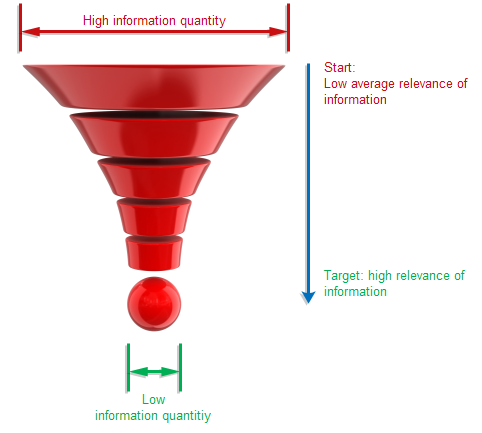
Irinos Measurement System
As with every technical system, efficient problem solving requires a systematic approach. A large amount of information with low average information relevance must be filtered in order to get high relevance information, which helps solving the problem:

Information filtering for solving problems
Follow this steps:
I.Problem description
Describe the problem as exactly as possible.
It can be very useful, to write it down on paper. This is especially important, if there are possibly multiple problems and it is unclear, whether they are related to each other. It may be necessary to formulate multiple problem descriptions.
II.Gathering information
Describe the situation before and after the problem occurred. The following questions may help:
oWas there any special situation or action before the problem occurred?
oHas the system been modified before the problem occurred?
oAre there any conspicuous symptoms after the problem occurred? Check the state of all status LEDs / displays: do they signal any errors?
III.Read the available diagnostic information. Try to find out, if the error occurred once or multiple times.
IV.Evaluating the information
Sort the information gathered in steps II and III by relevance using the following categories:
oNot relevant
oPossibly relevant
oProbably relevant
V.Verifying the information
Try to deliberately cause the problem by using the information of the category "probably relevant". Use a step-wise approach by concentrating on only one possible issue at once.
If this is not successful: try the same procedure for the other two categories.
Solving the problem is only possible, if it can be reproduced and if the reason for it is known.
Tips
oDifferentiation
If multiple problems occur, often no distinction is made between them. Always analyse only one problem. A simultaneous analysis of multiple problems is too difficult.
oKeep calm
Problems almost always need to be solved quickly. Thus there is always a lot of time pressure. However, it does lead to faster results. Keep calm and locate the problem in systematic steps.
oWatch for little details
Especially when it is difficult to locate the problem, it is important to watch for little details. Sometimes a LED or a suspicious noise provides more and better information than the best measurement device.
oSimplify
Especially if systems are complex, it is useful to reduce it to a minimized system, which runs without problems. Afterwards add complexity step by step until the problem occurs again.
